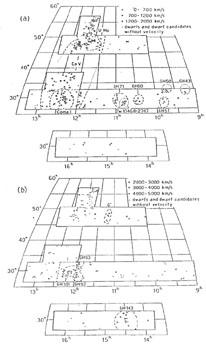


We next generalized the problem by a new study of the general field. Many recent searches have been made for dwarfs in voids but mostly for Im types using either radio or objective prism techniques. In our survey (Binggeli, Tarenghi, and Sandage 1990, hereafter BTS 90) we were searching for dE type dwarfs as well as Im's by inspecting long exposure III/aJ plates taken in 1980 with the Palomar 48in-Schmidt. The survey covers 1000 square degrees in two declination strips at +30° and +48°, centered on the supergalactic plane at R.A. = 12h but extending into the low density R.A. regions on either side of this plane. Figure 12 is a map of the resulting catalog entries for the dE and Im candidates. Our conclusions are (1) both Im and dE dwarfs are distributed in the same way as the luminous giants - numerous when the density of giants is high, sparse when giants are sparse; (2) dE ellipticals are predominately found in dense groups but the dwarf Im's are more widely dispersed, occurring away from high density regions in a similar way to the morphological segregation in clusters (cf. Section 1), (3) dE's in the general field are invariably close companions (satellites) of massive parents rather than existing alone in isolation, showing that dE's must form (or be incarnated) in the vicinity of a more massive galaxy, (4) the faint-end slope of the luminosity function for dE's in the sparse field is significantly flatter than in the Virgo and Fornax clusters. The Schechter alpha value of the faint end slope is 1 (flat!) in the field, compared with 1.2 in the clusters, similar to the result in Figures 10 and 11 for clusters and groups that differ from the predictions of the strong version of "biased galaxy formation". These results (BTS 1990), and those of Schombert and Bothun (1988), and of Eder et al. (1989) show, contrary to the "biased formation" model that (1) dwarfs have the same general spatial distribution as the giants, and (2) the dwarf to giant ratio decreases rather than increases in low richness regions compared to clusters.

|
Figure 12. Survey for dwarfs in the general field by BTS 89 in a 1000 square degree area on either side of, and passing through, the supergalactic plane. |